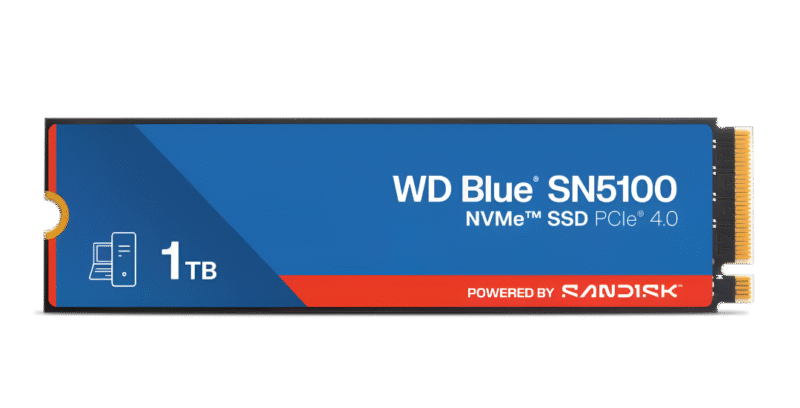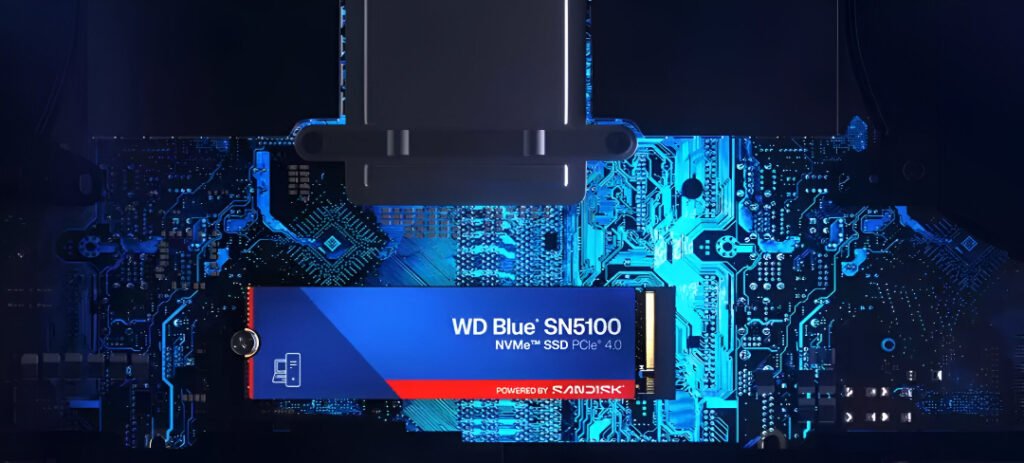SANDISK Blue series has long been a popular choice for budget-conscious users looking for reliable performance without overspending. The latest model, the SANDISK Blue SN5100, enhances this reputation as a PCIe 4.0 NVMe SSD. While it features a DRAM-less design, it still offers impressive speed and efficiency. But does it live up to its promises, or does its DRAM-less design hold it back? Let’s take a closer look.
Design and Build
The SANDISK Blue SN5100 displays a simple and efficient approach to SSD design. It features a sleek, single-sided M.2 2280 form factor that is easy to install in most motherboards or laptops. With no elegant RGB lighting or overbuilt aesthetics, it offers a clean layout that houses just two NAND chips and the controller, resulting in a compact footprint. This minimalist design contributes to its low profile and power efficiency, drawing only 3.8 to 4.3 watts during read operations, which is beneficial for battery life in portable devices.

The drive utilizes Host Memory Buffer (HMB) technology, allowing it to use up to 64 MB from the system’s RAM to compensate for the absence of onboard DRAM. It’s also paired with SanDisk’s nCache 4.0, which enables intelligent SLC caching to maintain consistent write performance.
One notable drawback is the absence of a built-in heatsink. While this keeps costs down, it raises concerns about thermal management under load. In real-world testing, the SN5100 runs warm to the touch during intensive tasks such as sustained large-file transfers or 4K video editing, reaching peak temperatures around 67°C in benchmarks without active cooling. This is higher than some TLC competitors but still within safe limits, as the operating temperature can go up to 85°C. For lighter workloads like web browsing, gaming, or office applications, it remains in the comfortable mid-50s°C range and shows no signs of thermal throttling, even in open-air desktop setups. However, if you’re engaging in continuous heavy multitasking such as running multiple virtual machines or rendering sessions in a compact laptop chassis, expect it to become noticeably warm.
The SSD also includes SSD Dashboard software for monitoring health, firmware updates, and cloning, which is a great feature for easy data migrations.
Performance
Where the SANDISK Blue SN5100 truly shines is in its performance, leveraging the PCIe 4.0 x4 lanes and NVMe 2.0 protocol to enable speeds that compete with higher-end TLC drives, despite the use of QLC NAND. The 1TB and 2TB models are rated for up to 7,100 MB/s in sequential reads and 6,700 MB/s in sequential writes. In CrystalDiskMark tests, these speeds are consistently achieved, with the 1TB variant reaching over 7,000 MB/s in reads and over 6,500 MB/s in writes during sequential workloads. This results in speedy OS boots and game loading times.
The random access performance is also impressive for a DRAM-less QLC SSD, with the 2TB model boasting up to 1,000,000 read IOPS and 1,300,000 write IOPS. This translates into quick responsiveness for everyday applications such as Photoshop or Excel. In extended tests such as transferring more than 100GB of mixed files, it averaged 3,100 MB/s in bidirectional throughput, outperforming many Gen4 competitors and even some entry-level Gen5 drives in value scenarios.
Gaming benchmarks indicate a reduction in load times by 20-30% compared to SATA SSDs. Additionally, its low latency (under 0.1ms in 4K QD1 reads) ensures smooth multitasking. While it may not be the absolute fastest in random writes compared to DRAM-equipped flagship models, its overall performance remains highly competitive.
Verdict
The SANDISK Blue SN5100 is an excellent choice for anyone looking to upgrade to PCIe 4.0 storage on a budget. It offers impressive speeds, solid reliability, and useful extras like migration software, all at prices that are 20-30% lower than its competitors. Although it features a DRAM-less QLC design, it performs well for everyday use. The drive also has good thermal management, allowing it to handle heat effectively. However, enthusiasts who engage in high-sustained workloads may want to consider adding cooling solutions for extra peace of mind. Whether you’re building a mid-range gaming rig, equipping a work laptop, or simply need additional storage without a hefty price increase, the 1TB version priced around ₹7500 is the fastest QLC SSD available on the market. The Gen5 hype may not be necessary for everyone.


